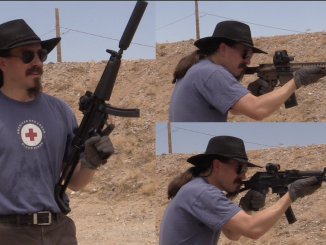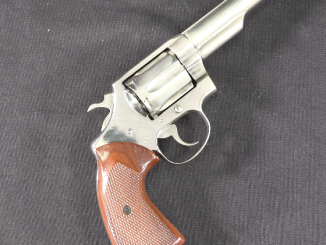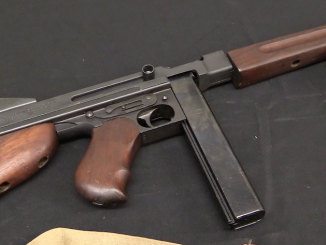John Browning’s original Model 1895 gas-lever machine gun was still in production by Colt when World War One broke out. It was not the most modern gun around by then, but it was available – and that was the most important feature for many potential buyers. Colt, however, had a lot of other larger orders to fill, and so in 1914 it arranged to subcontract the 1895 pattern gun to Marlin. Marlin (which reorganized to become Marlin-Rockwell in 1916) had a talented Swedish designer named Carl Gustav Swebelius who substantially modernized the design by redesigning it to use a straight gas piston instead of the original swinging lever. This, and its closed-bolt firing, made it a candidate for synchronized aircraft use.
After some further revisions to improve extraction, the gun was designated the 7 MG (model 1917) by the US, and some 38,000 were ordered. At some point the heavy barrel was replaced with a thinner, smooth profile barrel and the cocking handle changed from a loop to a simple “L” handle. In 1918, a new design of hydraulic synchronizer was adopted, resulting in a new designation of 8 MG. At the very end of the war, the Marlin was chosen for use in American light tanks, and 2,646 were converted for that purpose by installing Lewis-type barrel cooling shrouds and flash hiders. None of these reached Europe in time to see service during the war, though.
The Marlin 1917 machine gun is one of the least appreciated and understood of American military machine guns, and detailed information on them is quite sparse. This video was done with he best set of facts I was able to find, and I hope it is not wrong in any substantial area!




A very interesting study – the Colt M1895 and its variants history perhaps best described as ‘interesting’
Noting which, does anyone have a decent source for how many (and when e.g. were the Ypringa guns M1895’s?) were sold to who (ideally on line – fitting for at least the 20th century and as Croesus sadly and inexplicably didn’t pass on to me any of his gold and consequently my book budget – and space- limited). Grovelling thanks if you do.
I heard that this gun had a tendency to violently chew or tear soft/thin cartridge-brass owing to the gas system being changed. As a result, the cartridges given to air crews had to be the cream of the crop in terms of casing quality. I could be wrong.
“(…)could be wrong.”
Partially. Such problem appeared during development but was solved if you trust https://www.ibiblio.org/hyperwar/USN/ref/MG/I/MG-4.html
saying that:
in World War I, Swebilius modified the Colt-Browning gun by doing away with the lever and substituting a straight-line gas-actuated piston. Such a change presented problems of its own. instead of giving a slow and gradually accelerated backward thrust through a connecting rod arrangement, as in the case of the lever-operated weapon, the piston was driven back hard at the very beginning of its stroke. This caused a loss of initial extraction and resulted more often than not in tearing off the cartridge head instead of extracting the empty case. The fault was soon remedied by further modifying the action through the addition of greater weight to the piston. The first rearward movement of the bolt was thereby somewhat retarded.
I suppose the large .30 cal. stamping was to make sure users knew that the 7MG was NOT 7mm.
I recall reading that Phillipine Scouts just prior to WWII had to have a Browning 1917 replaced and received a Marlin in its place wrapped in newspapers dating from the previous war. Isuppose they improvised a mount. Also was used in anti aircraft role by merchant ships early in the war.
Thank you, Mr. M, for the detailed view of this genuinely and undeservedly forgotten weapon.
For more information, some of which contradicts Mr. M’s account, have a look-see here: https://www.marlinforum.com/articles/the-marlin-machine-guns.1/
This article misnames the synchronizer system, which was “Contantinescu,” originally adopted by the British and still used for cowl-mounted aircraft MGs into WWII.
Questions: What was the rate of fire after the Swibelius conversion? Was this the first automatic tilting-bolt firearm? What else used tilting bolts between the 6mm Remington-Lee and this gun? Who else is aware of H.W. McBride’s WWI memoir “A Rifleman Went to War,” in which he praises the ground-service .303 Canadian Colt-Browning for better accuracy than the Vickers?
Supposition: Marked “US 30 cal” because some US and French WWI aircraft were equipped with .303 Vickers and Lewis guns, and some Colt-Browning and later Marlin guns seemed to have been supplied to the British Commonwealth in .303.
“This article misnames the synchronizer system, which was “Contantinescu,””
Williams http://www.quarryhs.co.uk/miltech.htm
in articled Synchronisation systems http://www.quarryhs.co.uk/Synchro.pdf
use name Constantinesco-Colley hydrosonic gear alias CC i.e. name ending with “o” and without trailing comma. hydrosonic means it used sound wave in liquid for signal transmission, rather than pulling/pushing rod xor torque rod. This make it easily adaptable for various aeroplanes.
“What was the rate of fire after the Swibelius conversion?”
Above article states that generally for synchronization gears mileage might vary.
The RoF of a synchronised gun tended to be rather erratic because it varied with propeller speed. Theoretically, it was possible to achieve an ideal match between the propeller rpm and gun’s natural RoF, so that the gun was not slowed down at all. However, such harmony would obviously disappear as soon as the engine slowed down or speeded up. This particular problem was not solved until the adoption of the constant-speed propeller, which wasuncommon until the late 1930s.
“(…)substantially modernized the design by redesigning it to use a straight gas piston instead of the original swinging lever. This, and its closed-bolt firing, made it a candidate for synchronized aircraft use.”
Also, even in swinging arm version (1895/14) it was air-cooled and relatively light (important for then-used which have limited horsepower in engines at their disposal) make it attractive for using in aeroplanes.
It weighed 15,9 kg – for comparison Hotchkiss 1914 weighted 23,5 kg.
“Colt machine gun” was used as armament in some of Sikorsky S-16 fighters, see 12th image from top here: http://www.airwar.ru/enc/fww1/s16.html
(and some other were equipped with Vickers machine gun)
Lavrov’s gear was used. It was lacking – requiring a lot of effort from maintenance personnel to keep working and unable to provide synchronization in whole spectrum of engine power settings – but anyway was produced and used due to lack of better alternatives.
The Netherlands interned American aircraft after alighting within Dutch jurisdiction after a battle over the high sea with Germans.
P550
Digest of International Law
Ensign Joseph Eaton, USN
4 June 1918
North Sea Patrol
Alighted on surface due to engine trouble west of Terschelling.
5 June 1918 Interned in Holland
I’m not sure if this accounts for the gun in the Dutch military museum.
In the rush of WWI production, how would the air service get an improved grade of .30-’06? Were some plants better, and therefor slotted to the Air Force, or were batches graded on the basis of inspection?
Did any of you actually watch the video?
“(…)talented Swedish designer named Carl Gustav Swebelius(…)”
He would later design M42 sub-machine gun:
https://modernfirearms.net/en/submachine-guns/u-s-a-submachine-guns/ud-m42-eng/
This make him belonging to very few of fire-arms designer, whose independent from each other designs for military use managed to enter production during both World Wars.
At first, they just empirically selected batches of cartridges that worked normally.
Then the production of special cartridges began.
https://forum.cartridgecollectors.org/t/synchronized-machineguns/6744/17
https://forum.cartridgecollectors.org/t/info-on-anm2-30-06-ammunition-neded/15545
https://forum.cartridgecollectors.org/t/7-62×63-u-s-c-co-18-with-without-asterisks/7007
https://forum.cartridgecollectors.org/t/please-id-this-one-usc-co-18-new-guy-again/11296
https://forum.cartridgecollectors.org/t/what-is-the-grove-for/29087/10
From an anecdotal sample of 1. The Colt/Marlin guns may have also been issued as WWII US Civil Defense/Beach Patrol guns. 30-ish years ago the rusted remains of one was found in what was believed to be the area of one of the guard posts that was destroyed by the hurricane of 1944 in Brigantine NJ. It made quite the stir in the Atlantic City Press at the time.
A great many Marlin MGs were sold to the post-Dunkirk United Kingdom along with fully a quarter (or even a third?) of the reserve stocks of .30-06 ammunition, M1917 rifles, Lewis guns, Thompson SMGs, etc. These un-used tank and aircraft machine-guns were shipped to Raritan, NJ, where they were summarily “sold as scrap” to U.S. Steel, which then turned around and sold them to the UK in order to get around the U.S. neutrality laws, and the anti-interventionist, isolationist political preferences of the preponderance of American voters. All done before Lend-Lease, mind you.
How many of these Marlins arrived in Britain would be another research project.
“(…)All done before Lend-Lease, mind you.”
So… how it was glued into U.S. legal system? My understanding is that U.S.A. were willing to sell arms, but only if paid (“cash and carry” approach), though I confused why this was not illegal under Neutrality Act 1935.
Cash and carry, yes.
On 4 June 1940, the date of the Winston Churchill “fight on the beaches” speech, the U.S. Department of Defense declared that U.S. war reserves did not require half a million bolt-action rifles, 25,000 automatic rifles or BARs, thousands of machine guns, and hundreds of howitzers and mortars. These went to a U.S. army port in Raritan, New Jersey where the surplus weapons were transferred to U.S. Steel Corporation, and then duly signed over to the UK for $37.6 million dollars. Initial shipments included a quarter of a million U.S. rifles, mostly the Model 1917 “American Enfield” conversion of the P-14 rifle produced for the UK in WWI. This weapon consisted of a .300 caliber (.30-06) Mauser-derived bolt-action rifle that had equipped the majority of AEF “doughboys” in 1917 and 1918. Also sent to the UK: fully a quarter of the ammunition in U.S. reserve stocks, some 130 million rounds, or enough for approximately 250 cartridges per rifle, and 80,000 machine guns, mostly modified aircraft models from obsolete biplanes. Many North Americans, entertaining beliefs that privately owned guns protected households from government repression, donated personal firearms to residents of the UK.
I have read that the Marlin guns were largely issued to merchant ships to give them some sort of anti-aircraft defence. Knowing the British government, at the end of the war they would have been scrapped.
Thanks. Certainly a lot of Lewis guns were also apparently used for small craft. Perhaps there are further details as to what ships got the Lewis in .30-06 vs. .303 or one or another U.S. MGs like the Marlin?
For WWI, I have seen a photo of fishermen pursuing the shoals of herring taking time out for air defense against German planes with a brace of ex-Canadian Ross straight pull rifles! At one point, the Italian army had a platform with a series of overhead positions for a group of Carcano-armed riflemen to fire in unison against Austro-Hungarian aircraft, and the proclivity of the Russians and Soviets to insist that anything capable of launching a bullet being used to target low-flying aircraft perhaps needs no further elaboration.
“(…)Lewis guns were also apparently used for small craft.(…)”
For photographic evidence, see 1st photo from top: https://www.historicalfirearms.info/post/153360337854/in-action-lewis-gun-m1917-the-photographs
I have just finished reading the History of The Maritime Regiment Royal Artillery, which supplied well trained gunnery crew filling the command positions for the defence armament of British Merchant Navy ships and those of ALL Allied Nations during the 1939-45 War (including acting as advisers to the USN Naval Guard training for the same role). A combination of the Royal Navy and the Army supplied the weapons for these merchant ships; 6 and 4inch, 12 and six pounder, single barrelled 2pdr pompom, 20mm guns from the Navy, while the army supplied 40mm Bofors (later in the war), .5 and .303inch Vickers guns, Lewis guns, as well as captured enemy weapons such as the Italian 20mm and 8mm Breda. Ity makes comment that the entire stock of Marlin MGs received in the UK eventually were fitted to merchant ships, probably 15-20% via way of the Home Guard. They cost the UK taxpayer in subsequent Lend-Lease payments per weapon USD112.48c, plus packaging and transport to the UK. Probably a fifth of the total were lost at sea by enemy action (still paid for, a similar total lost to the Thompson M28 purchased). For all its faults, the Marlin in both of its variants, Land Service and Air was popular weapon. Not because of its design, but, the fact that it stood up to the salt environment very well, reducing the time spent in in-depth cleaning! They remained in service until 1945, a huge number were lost at sea, and transferred as gifts to the Soviet Nation, those for Allied ships written off. Ships carried between 4 and 12 normally, but troops ships such as the Queen Elizabeth etc, carried between 24-36 which manned by the troops en-transit. Not to bad for a piece of junk sold off to the UK at inflated prices. The mounts fitted were ingenious, and varied upon which Army workshop manufactured them.
A very late note on the double trigger, one for the operator and one up top for the synchronizer. The synchronizer does not prevent fire when the propeller blade is in the way of the barrel; it actually fires the gun (single shot!) each micro-second the blade is out of the way. Thus the operator pulls the manual trigger, which then allows the synchronizer to start setting the gun off. This is why the faster lock time of closed-bolt guns was preferable for this use.
Late in WWI there were Sopwith Camels fitted with (open bolt) twin Lewis guns on the cowling; how these were synchronized I haven’t the foggiest idea.
The modified Navy guns were designed around one manufacturers ammo and did not operate well with the other major US manufactured ammo…the issue was with different powders being used. While the Navy utilized all of its 1895 and 1895/15 Diggers, the Marlins were sidelined. Near the end of the war about half of US operated aircraft had been equipped with Marlins which INCLUDED twin observer mounts. There are photos of such on the internet.